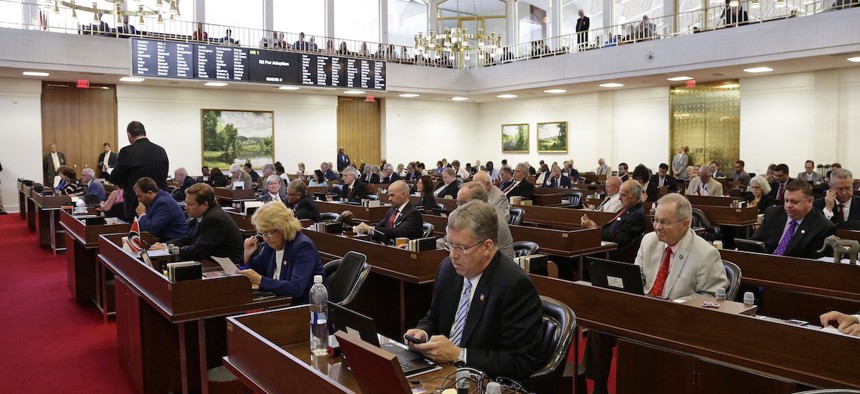Republicans Maintain Advantage in Control of State Legislative Chambers

In this Tuesday, July 24, 2018, file photo, members of the North Carolina House gather for a special session at the General Assembly in Raleigh, N.C. (AP Photo/Gerry Broome, File) Associated Press
Democrats failed to make major inroads in state legislative races, in many places leaving them at a disadvantage in the upcoming redistricting process.
Democrats in several state legislatures saw their hopes for claiming majorities in more chambers slip away Wednesday as early election returns indicated that Republicans largely maintained or increased their legislative power.
“I think the overall results are a big disappointment for the Democrats,” said Peverill Squire, a political science professor at the University of Missouri. “It’s not that they lost a terrific amount of ground like they did in 2010, but they thought they had some opportunities to pick up some chambers and for the most part it appears like they failed to do that. I think it leaves them in a position where, in some cases, they have to be concerned about how redistricting will play out with Republican control in some of the legislatures.”
According to initial returns, Republicans held onto a narrow majority in the Texas House. The GOP picked up four seats in the North Carolina House, while Democrats gained a single Senate seat, leaving both chambers in Republican control but short of a veto-proof majority under Gov. Roy Cooper, a Democrat who won re-election Tuesday.
Texas and North Carolina were two of a handful of state legislatures that had been eyed as competitive for Democrats. In North Carolina, Democrats needed to gain five seats to flip the Senate and six seats to flip the House, but also had to avoid losing in districts they flipped two years ago. Instead, five Democratic incumbents in those areas lost to Republican challengers, an outcome that N.C. House Speaker Tim Moore said was indicative of broad support for his party’s platform.
“Voters returning a strong Republican majority to the North Carolina House of Representatives tonight reflects the powerful momentum behind policies that promote economic prosperity, educational achievement, and safety for families,” he said in a statement.
In Texas, Democrats needed nine seats to gain control of the House and four to flip the Senate. Experts had thought that the demographics there—a growing Latino population and increasing numbers of younger voters—had favored Democrats, although a total flip was always considered a long shot. Incomplete returns indicated that Republicans would hold their majority; exact margins were unclear due to outstanding mail-in ballots.
Republicans have controlled a majority of state legislatures for the past decade, and because most states let their lawmakers draw the electoral maps, that advantage has given them outsized control over the boundaries that help determine which party remains in power.
Prior to Tuesday, Republicans held 59 of the 98 chambers that have partisan control—or 60%. As of Wednesday, they have trifectas—controlling both legislative chambers and the governor’s office—in 22 states, compared to 15 for Democrats, according to the National Conference of State Legislatures. That includes Montana, where Republicans on Tuesday won the governor’s race for the first time in 16 years.
At least two of those chambers—the House and Senate in New Hampshire—had flipped to Republican control as of Wednesday (a fairly frequent occurrence there, Squire said: “It’s the nature of that particular legislature”). Several other races—including the Arizona House and Senate, the Pennsylvania House and the Michigan House—were too close to call. At least one of those—the Arizona House—seemed primed to flip control to Democrats, which Squire said could be a lone victory in a landscape rife with disappointment for the party.
“They haven’t been competitive there for a long time, and they might take one or both chambers,” he said. “That’s sort of the one bright spot, along with the presidential race.”
If those numbers hold, the 2020 election will feature the fewest party-control changes since at least 1944, when only four chambers flipped, according to the National Conference of State Legislatures.
This year was particularly important for state races, as the winners of those legislative battles will have control over the redrawing of the electoral boundaries that help decide which party controls Congress and government for the next decade. In some states, Democrats have been largely locked out of that process for the last 10 years, and, failing drastic changes in late returns, are likely to remain relatively powerless for the next 10, though the process does vary from state to state.
In Wisconsin, Democrats highlighted that they prevented Republicans from gaining legislative supermajorities, which will mean Democratic Gov. Tony Evers will be able to veto plans he considers too partisan.
"Wisconsin is ground zero for Republicans rigging the maps, and this year, we stopped the GOP from getting total power over the process,” said Democratic Legislative Campaign Committee President Jessica Post in a statement.
Wisconsin's redistricting in 2011, which heavily tilted the state toward Republicans, was the focus of a 2019 Supreme Court decision that concluded federal courts can't get involved in evaluating the maps legislators draw.
“It’s a risk, certainly, because the Supreme Court to this point has signaled to state legislators that they’re free to pretty much pursue partisan gerrymanders as much as they would wish,” Squire said. “We’re all going to have to wait and see exactly what the numbers look like and how much flexibility the legislatures that are going to do redistricting have in terms of just drawing lines around populations, but I’m sure the Democrats are quite disappointed.”
Kate Elizabeth Queram is a staff correspondent for Route Fifty and is based in Washington, D.C.
NEXT STORY: Oregon Decriminalizes Hard Drug Possession, While Five States Pass Marijuana Ballot Measures





